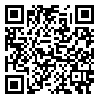BibTeX | RIS | EndNote | Medlars | ProCite | Reference Manager | RefWorks
Send citation to:
URL: http://ioh.iums.ac.ir/article-1-609-en.html

 , N Khanjani
, N Khanjani 
 , F Nadri *
, F Nadri * 
 , A Nadri
, A Nadri 
 , A Nadri
, A Nadri 
 , M Ahmadian
, M Ahmadian 
 , A Toolabi
, A Toolabi 
 , E Karimi Bami
, E Karimi Bami 

Background and aims: Adequate lighting in work environments can increase productivity and concentration and reduce fatigue. Light and illumination studies have been done mainly in industrial environments, and public or administrative environments were less under consideration. The aim of this study was to evaluate the ultraviolet radiation and illumination level at Kerman Medical Sciences University libraries.
Methods: In this study, the total, natural and artificial amount of illumination was measured at two different times, at the center of the designated stations in 14 study halls and the height of 30 inches by Hagner (Model EC1) luxmeter. Also, ultraviolet radiation (UVB & UVA) was measured by Hanger (Model S4) equipped with UVB & UVA detectors. The results of ultraviolet radiation and illumination level measurements were compared with standard using Excel software.
Results : The overall, natural and artificial illumination level, in 28.57%, 100% and 71.42% study halls was less than the National and IESNA standard (300 lux). The School of Nursing has the highest amount of UVB and UVA radiation in both total and natural light measurements. The Shahid Bahonar Hospital, men’s section had the highest amount of UVB and UVA radiation in artificial light measurements.
Conclusion: Initiatives such as proper alignment of bulbs, periodic dusting and cleaning, regular replacing of burnt bulbs, using study desks with the appropriate level of brightness, placing lamps at appropriate heights, and using bulbs with less UV radiation can improve the lighting situation in libraries.
Received: 2011/12/25 | Published: 2012/01/15
| Rights and permissions | |
 |
This work is licensed under a Creative Commons Attribution-NonCommercial 4.0 International License. |



